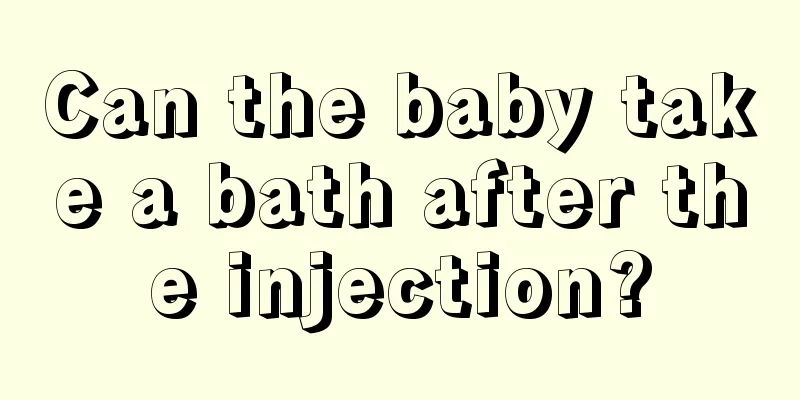Can the baby take a bath after the injection?

|
It is better not to give the baby a bath immediately after the injection. At this time, you should calm your baby's emotions first, and also pay attention to whether there are any abnormalities in the skin where the injection was given. If any redness, swelling or itching is found, you must go to the hospital for examination in time to avoid some sequelae. Wait until 24 hours later before bathing the baby, which will be better for the body. Intravenous care During the infusion process, nurses should strengthen patrols, carefully observe the child's infusion reactions, focus on whether there are drug allergic reactions, carefully check changes in the condition, patiently answer questions raised by parents, and enthusiastically help parents solve various difficulties in the nursing process. Common reactions in children during infusion include: irritability, hyperactivity, crying, etc. To deal with these children, parents can be provided with movable infusion stands and the children’s boredom can be eliminated through scene changes. If hospital conditions permit, a children's playground can be built to allow children to complete the infusion process in a relatively pleasant environment such as watching cartoons. In addition, nurses can use the time of their rounds to provide health education to parents, impart care knowledge for preschool children, help parents acquire correct and scientific nursing knowledge, parenting knowledge, and some simple and practical nursing skills, and provide extended services for the effective rehabilitation of sick children. Post-transfusion care The focus of post-infusion care is the treatment of the puncture site after the needle is removed. In clinical practice, improper pressure after needle removal often causes bleeding or hematoma at the puncture site, which causes pain to the child and sometimes has a significant impact on the doctor-patient relationship. Specific nursing measures: ① Remove the needle correctly. When removing the needle, be careful to be gentle and precise, separate the tape while communicating with the child, and quickly press the needle hole for 5 seconds after removing the needle, then let the parents continue pressing. ②Tell parents the correct way to perform the compression. Inform parents not to rub when pressing to prevent hidden bleeding at the puncture site, which may lead to local skin cyanosis and, in severe cases, hematoma. Inform parents that they need to press the needle hole for about 5 minutes, and after the bleeding stops, they need to stay in the clinic for observation for more than 20 minutes, and only leave after confirming that the child has no adverse reactions. The characteristics of preschool children make infusion difficult. Not only does it require very high clinical experience, puncture techniques and psychological qualities of nurses, but it also requires humanistic care for children that integrates psychological, mental and disease prevention during the entire infusion process. In order to reduce the painful memory of "injections" in children, alleviate their fear, and cooperate with the infusion operation, nurses must first communicate well with the children, build a bridge of communication, gain the children's trust, guide and encourage them to face challenges bravely, and cooperate with the treatment with proactive behavior. |
<<: Why does my child complain of stomachache after eating?
>>: What should I do if my child has a monkey skin disease?
Recommend
What are the symptoms of mycoplasma infection in children
Mycoplasma is extremely harmful to human health, ...
Acupuncture treatment of lameness in children
When the human body is carrying heavy objects or ...
Why does my child keep blinking?
In life, there are many reasons why children blin...
What causes pimples on children’s gums?
The fleshy bumps on children's gums may be ca...
How to relieve children’s poor appetite?
If a child has a poor appetite, he will eat less,...
What to do if children have hand, foot and mouth disease
Everyone knows that hand, foot and mouth disease ...
White crusty scalp
Babies with pink and tender skin have always been...
Why does my child have no snot but keeps sniffing his nose?
Children are prone to runny noses. Parents need t...
How to judge whether it is normal for the baby's belly to rise and fall when breathing
Now, actually, if you want to know whether the ba...
What causes prickly heat in children?
Children are very prone to prickly heat, especial...
What are the ways to help children grow taller?
Children are our future, and their physical healt...
What does it mean when your baby has baldness on his pillow?
Baldness on the back of the head is a common prob...
How to treat rashes in infants
Parents are more worried about rashes in young ch...
What are the early symptoms of cerebral palsy in children
With the increasing severity of air pollution and...
What to do if infants and young children have red and swollen throats
Newborns have very low immunity and their organs ...









